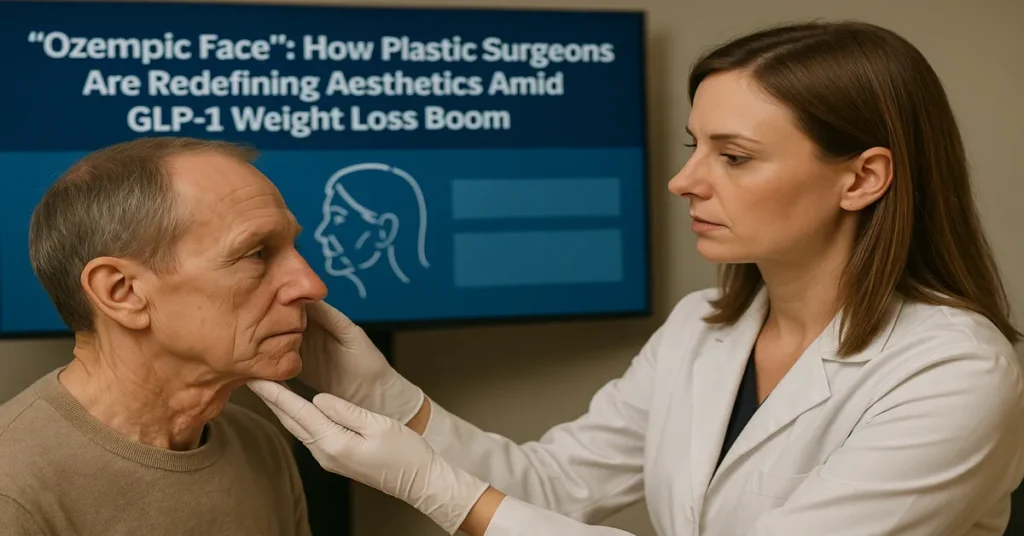In the rapidly evolving world of health and aesthetics, new conversations are emerging—not just about body transformation, but also about the unexpected effects of medical weight loss on facial structure. Enter the term “Ozempic face.” Coined by plastic surgeons and amplified by media, this phenomenon highlights how rapid weight loss induced by GLP-1 medications like Ozempic and Wegovy is reshaping not just waistlines but jawlines—and often not in a flattering way – plastic surgeons Ozempic face.
For plastic surgeons, this trend has opened up new aesthetic challenges and innovations. In this in-depth guide, we’ll unpack what Ozempic face is, why it happens, how plastic surgeons are responding, and what it means for the future of non-surgical and surgical facial rejuvenation.
Chapter 1: What is “Ozempic Face”?
“Ozempic face” is an informal term used to describe facial volume loss associated with rapid weight loss from GLP-1 receptor agonists like Ozempic (semaglutide), Wegovy, and Mounjaro.
Key Characteristics:
- Sunken cheeks
- Hollow temples
- Deflated nasolabial folds
- Prominent jowls or sagging skin
- Dull or aging appearance
The irony? Many people take these medications for their impressive weight-loss effects—but then they’re surprised when the transformation ages their face by years.
Chapter 2: The Science Behind Ozempic and Facial Fat Loss
Ozempic was originally developed as a type 2 diabetes medication. But its ability to mimic GLP-1 (glucagon-like peptide-1)—a hormone that regulates appetite and blood sugar—made it wildly popular for weight loss.
How Ozempic Works:
- Slows gastric emptying, helping users feel fuller for longer.
- Reduces hunger cues in the brain.
- Promotes consistent, often rapid, fat loss.
Why the Face is Affected:
The human face contains fat pads that provide structure, youthfulness, and contour. When the body loses fat too quickly:
- These pads shrink or disappear.
- The skin may not rebound, especially with age.
- Bone and muscle structure becomes more visible, exaggerating aging signs.
For younger patients, this can result in a “gaunt” look. For older patients, it can dramatically accelerate the appearance of aging.
Chapter 3: Plastic Surgeons’ Role in Addressing Ozempic Face
As this side effect has grown more visible—especially among celebrities and influencers—plastic surgeons have become frontline responders in treating “Ozempic face.”
Top Concerns Patients Present:
- “My cheeks feel hollow.”
- “I look tired all the time.”
- “I lost the weight, but now I look older.”
- “My face doesn’t match my body.”
Let’s dive into how surgeons are helping clients navigate this aesthetic paradox.
Chapter 4: Non-Surgical Solutions for Ozempic Face
Before reaching for the scalpel, plastic surgeons are turning to non-invasive and minimally invasive treatments. These are often preferred by patients in their 30s to 50s looking for reversible or temporary enhancements.
1. Dermal Fillers
Hyaluronic acid fillers (like Juvederm or Restylane) are used to:
- Restore volume in cheeks, temples, and nasolabial folds.
- Support sagging skin.
- Re-contour the jawline.
Some surgeons are now using Sculptra, which stimulates collagen production over time, for a more gradual restoration.
📝 Note: Overuse can lead to a “pillow face” appearance—so moderation and skilled injection are key.
2. Skin Tightening Devices
- Ultherapy (ultrasound-based)
- RF microneedling (radiofrequency + microneedling)
- Thermage (radiofrequency)
These stimulate collagen and elastin to tighten loose skin from fat loss.
3. PRP and Biostimulants
Platelet-Rich Plasma (PRP) and biostimulatory injectables can improve skin quality and stimulate natural tissue regeneration.
Chapter 5: Surgical Options for Severe Cases
When facial aging becomes too pronounced—or when filler isn’t enough—plastic surgeons may recommend surgical intervention.
1. Fat Grafting (Fat Transfer)
Fat is harvested from other body areas (like the thighs) and injected into the face. This is a natural, semi-permanent alternative to synthetic fillers.
Pros:
- Uses your own tissue
- Long-lasting
- Looks natural
Cons:
- Requires downtime
- Slight unpredictability in how fat settles
2. Facelift or Mini Facelift
Especially in patients over 50, sagging caused by deflated fat pads may require a lower or full facelift to lift and reposition tissue.
Modern techniques focus on:
- Shorter incisions
- Deep plane lifting (for more natural movement)
- Combination with fat grafting for better contour
3. Neck Lift or Jawline Sculpting
As weight loss often exaggerates neck sagging, some patients combine facial procedures with neck tightening or liposuction.
Chapter 6: Aesthetic Ethics in the Age of GLP-1s
With the explosion of GLP-1 medications, plastic surgeons are now navigating new ethical waters.
1. Should We Pre-Warn Patients?
Should doctors or weight-loss providers warn patients about the facial consequences of rapid weight loss?
Many plastic surgeons argue YES—proactive conversation leads to better patient satisfaction and realistic expectations.
2. Natural vs Enhanced
Some patients find joy in their thinner faces. Others want to preserve their youthful fullness. The surgeon’s job is to balance natural beauty with patient preference, never pushing procedures unnecessarily.
3. Are We Fueling a Vicious Cycle?
There’s concern that some patients, especially celebrities, are caught in a loop:
- Use Ozempic to get thin
- Use fillers/surgery to correct the facial aging
- Continue meds and repeat procedures
Plastic surgeons are beginning to advocate for holistic patient health, working with endocrinologists and nutritionists to guide safer, slower weight loss when possible.
Chapter 7: Who is Most At Risk for Ozempic Face?
While anyone can experience facial changes from rapid weight loss, certain factors raise the likelihood:
| Risk Factor | Description |
|---|---|
| Age | Over 40s see less skin elasticity |
| Baseline Facial Fat | Naturally lean faces lose fullness faster |
| Amount of Weight Lost | Losing more than 20–30 pounds accelerates volume loss |
| Speed of Weight Loss | Rapid shedding doesn’t allow skin to adjust |
| Skin Quality | Sun damage, smoking, and genetics affect bounce-back |
Chapter 8: Preventing Ozempic Face—Is It Possible?
Yes—and many plastic surgeons now recommend a preventative approach, especially for patients who are just beginning semaglutide or similar medications.
Tips to Prevent Facial Aging During Weight Loss:
- Go Slow: Aim for 1–2 pounds of weight loss per week.
- Hydrate Skin: Use serums with hyaluronic acid and ceramides.
- Build Collagen: Consider early use of PRP or collagen-stimulating devices.
- Strength Training: Muscle toning in the jaw and neck improves facial tightness.
- Talk to a Plastic Surgeon Early: A consultation at the start of your journey helps build a long-term plan.
Chapter 9: Real Patients, Real Transformations
✨ Case Study 1: The Executive Rebrand
Susan, 49, lost 40 pounds on Ozempic. While thrilled with her body, she felt “aged overnight.” A combination of Sculptra and Ultherapy restored her confidence without surgery.
✨ Case Study 2: The Mini-Lift Miracle
Martin, 56, opted for a mini facelift and fat grafting after losing 60 pounds. The result? A slimmer, youthful face that matched his new physique.
✨ Case Study 3: The Preventative Pro
Tasha, 37, began Ozempic with a pre-planned skin care and microneedling regimen. She experienced minimal facial aging and never needed filler.
Chapter 10: The Future of Aesthetics in a GLP-1 World
Plastic surgeons are now anticipating a massive wave of facial rejuvenation cases tied to the popularity of weight-loss injections. As GLP-1 drugs become more accessible, aesthetic medicine will adapt in real-time.
Predicted Trends:
- Ozempic Recovery Packages: Clinics offering bundled services like filler, skin tightening, and wellness coaching.
- AI-based facial mapping: To track subtle changes in fat and skin tone pre and post weight loss.
- Proactive Aesthetic Planning: Surgeons working with weight-loss providers from the start.
Conclusion: Embrace Change, Plan Ahead
“Ozempic face” is not a flaw—it’s a side effect of transformation, one that deserves understanding, compassion, and thoughtful correction when desired.
Plastic surgeons today are not just reshaping faces—they’re helping patients rediscover confidence, balance, and harmony as they navigate a new body and identity. Whether you’re at the start of your GLP-1 journey or seeking to reclaim facial vitality post-weight loss, the options are more sophisticated—and natural-looking—than ever before.
Weight loss is a personal victory. But when your face tells a different story, know that expert hands are ready to help you match the mirror to your momentum.







